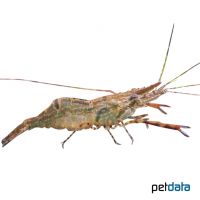Red Claw Shrimp (Macrobrachium assamense)
| Red Claw Shrimp Macrobrachium assamense | |
|---|---|
| Name | Red Claw Shrimp |
| Name Lat. | Macrobrachium assamense |
| Family | Palaemonid Shrimps |
| Family lat. | Palaemonidae |
| Order | Decapods |
| Order lat. | Decapoda |
| Origin | Southeast Asia |
| Habitat | Streams, ponds |
| Diet | Detritus, algae, shrimp food |
| pH | 6.5-8.0 |
| Behavior | ♂ territorial |
| Keeping | Harem |
| Care Level | Easy |
| Reproduction | Egg layer |
| Breeding | Simple |
| Life Span | 2-4 years |
| Protection | No |
| Metric Units | |
| Size | 6-8 cm |
| Temperature | 20-29 °C |
| Hardness | 8-15 °dH |
| Aquarium | ~ 60 l |
| US Units | |
| Size | 2.4"-3" |
| Temperature | 68-84 °F |
| Hardness | 142-267 ppm |
| Aquarium | ~ 15 gal |
Distribution and habitat
The distribution area of the annelid shrimp stretches from India to Nepal, Thailand and Myanmar. They live in stagnant or slowly flowing waters.
Maintenance
They need a well-structured aquarium with many roots, some robust plants and large stones as well as a moderate current. The substrate of sand or gravel should be partially covered with foliage (e.g. sea almond leaves, oak leaves).
No ammonia, ammonium and nitrite should be detectable in the aquarium water, the nitrate value should not exceed 100 mg/l. To ensure water quality and oxygen content, a filter and heater adapted to the size of the aquarium is required, as well as lighting for the species-appropriate day-night rhythm of the animals. When choosing the filter, special care should be taken to ensure that the animals cannot be sucked in.
Diet
They feed on animal organisms, carrion, snails and dead plant material (sea almond leaves). The diet consists of a combination of live or frozen foods, such as cyclops, daphnia, mosquito larvae, artemia, mysis and tubifex, or a commercial frozen special food mix supplemented with dry foods (tablets, granules) for crayfish and shrimp. Occasionally, slow and weakened fish are also preyed upon.
Regular and varied feeding promotes health and prevents deficiency symptoms. Unaccepted food must be removed after 2-3 hours
Behaviour and compatibility
They should be kept in a harem, one male with several females and are well suited for a community tank with not too small fish. Males are territorial within the species. Keeping multiple harems is only recommended in larger and richly structured tanks.
Basically, only compatible animals with similar demands on water quality and water temperature should be kept together
Reproduction and breeding
The males have slightly larger claws than the females. Breeding annelid shrimp is easy, as they only go through one larval stage. The females perform a kind of brood care during the first days and do not eat food during this period. The young must be fed several times a day with special rearing food, such as Artemia nauplii or fine dry or frozen food.
Important
As an undemanding and easy-to-breed species, the annelid shrimp is one of the most popular shrimp in freshwater aquariums. It owes its name to the pronounced banding of the second claw legs, which is especially visible in juvenile animals.
Foliage (sea almond tree, oak, beech, etc.) not only provides cover, but when decaying encourages the development of microorganisms that provide a valuable secondary food source
The well-being of the animals should be monitored regularly. Temperature should be checked daily, pH, hardness and nitrate levels at least every 14 days. Regular partial water changes are recommended, even when contaminant levels have not yet reached the upper limit. Sudden changes in water quality should be avoided. Newly introduced animals must be accustomed slowly to the water in the aquarium.
Further literature can be found in your pet store
References
Text: petdata; Image: petdata
Source: KARGE & KLOTZ (2007): Süßwassergarnelen aus aller Welt, Dähne Verlag; ENGELMANN & LANGE (2011): Zootierhaltung - Tiere in menschlicher Obhut: Wirbellose, Verlag Harri Deutsch
